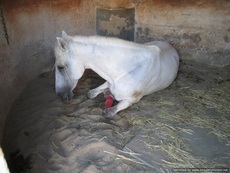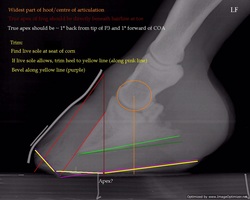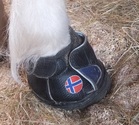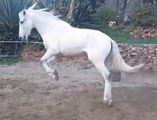An article by Casareño's owner, Pat Laing

Teamwork, handling the vet and farrier
In the first few months the hardest challenge that I faced was that I had serious doubts about whether my horse was getting the right treatment. I had already made contact with The Laminitis Site and had read all the information about laminitis rehabilitation that Andrea had sent me. It all made complete sense. I wanted to follow the TLS recommended protocol as a matter of urgency. My vet and farrier said that it could be “disastrous”! More than 2 months had passed and clearly Casareño was getting worse. I was feeling more and more desperate and helpless.
In the first few months the hardest challenge that I faced was that I had serious doubts about whether my horse was getting the right treatment. I had already made contact with The Laminitis Site and had read all the information about laminitis rehabilitation that Andrea had sent me. It all made complete sense. I wanted to follow the TLS recommended protocol as a matter of urgency. My vet and farrier said that it could be “disastrous”! More than 2 months had passed and clearly Casareño was getting worse. I was feeling more and more desperate and helpless.

I found that my horse's recovery only started when I had a vet and farrier team in place that would work to the TLS guidelines. Good teamwork was the key to our eventual success. I needed the vet to take good marked-up x-rays so that accurate trimming guidelines could be produced and I needed the farrier to follow the guidelines. My main role was to make sure that Casareño's diet was correct, that I provided protection for his feet, sought help from TLS when in doubt and arranged regular trimming visits and x-rays, where needed, to provide ongoing guidance for the trim.
What do you do if your hoof-care team does not want to follow the guidelines that have been provided by The Laminitis Site?
It is very difficult to challenge your vet's treatment plan. Your vet's reaction will typically be “I have studied for 7 years and practised for 'n' years and you have just read something on the internet!”. The farrier may have a similar attitude. The farrier may believe that remedial shoeing is the only solution. A barefoot trimmer may have no experience with laminitic feet or may have their own methodology that they want to follow.
In addition, I had the language barrier. My vet and farrier's first language was Spanish – discussion and debate was difficult!
I only had 3 options:- 1) Get the team to buy-in to the TLS recommended rehab protocol; or 2) as the owner and the person paying the bills just insist that they follow this protocol; or 3) change the team. In the end, I used a combination of all 3 options to achieve the eventual successful buy-in.
Getting vet/farrier to buy-in (this is so important because once you have this in place the rest is fairly plain sailing!)
First, you have to have confidence in the TLS guidelines. You may have heard or read different approaches to laminitis treatment. You will probably be feeling under a lot of stress but I urge you to take the time to read the material that TLS will have sent you and check out some of the Case Studies. If you are in the situation where you need to get the vet/farrier to change their approach, you will not be successful if you yourself show uncertainty.
It helps if the vet and farrier can be reassured that the TLS recommended protocol is based on evidence-based scientific research and has been produced by veterinarians and farriers that are highly regarded in this field of expertise (not just some latest fad on the internet!).
Let the vet and farrier know, when you make the appointment with them, that you want to discuss the treatment plan with them and ask them to allow a little extra time for you to have these discussions. Be prepared to pay for a slightly longer visit if necessary.
It is very difficult to challenge your vet's treatment plan. Your vet's reaction will typically be “I have studied for 7 years and practised for 'n' years and you have just read something on the internet!”. The farrier may have a similar attitude. The farrier may believe that remedial shoeing is the only solution. A barefoot trimmer may have no experience with laminitic feet or may have their own methodology that they want to follow.
In addition, I had the language barrier. My vet and farrier's first language was Spanish – discussion and debate was difficult!
I only had 3 options:- 1) Get the team to buy-in to the TLS recommended rehab protocol; or 2) as the owner and the person paying the bills just insist that they follow this protocol; or 3) change the team. In the end, I used a combination of all 3 options to achieve the eventual successful buy-in.
Getting vet/farrier to buy-in (this is so important because once you have this in place the rest is fairly plain sailing!)
First, you have to have confidence in the TLS guidelines. You may have heard or read different approaches to laminitis treatment. You will probably be feeling under a lot of stress but I urge you to take the time to read the material that TLS will have sent you and check out some of the Case Studies. If you are in the situation where you need to get the vet/farrier to change their approach, you will not be successful if you yourself show uncertainty.
It helps if the vet and farrier can be reassured that the TLS recommended protocol is based on evidence-based scientific research and has been produced by veterinarians and farriers that are highly regarded in this field of expertise (not just some latest fad on the internet!).
Let the vet and farrier know, when you make the appointment with them, that you want to discuss the treatment plan with them and ask them to allow a little extra time for you to have these discussions. Be prepared to pay for a slightly longer visit if necessary.
Give the vet and farrier printed copies of TLS's trimming diagrams and the scientific paper on which they are based – Clinical Outcome of 14 Obese, Laminitic Horses Managed with the Same Rehabilitation Protocol by Dr Debra Taylor et al 2014. Make sure that they know that the authors of the protocol are highly regarded - the current leaders in this field.
Be confident and assertive that you want them to follow this protocol – even offer to put it in writing (professionals are very wary of being sued if things go wrong – if they have your clear instructions it takes that risk away for them).
Be confident and assertive that you want them to follow this protocol – even offer to put it in writing (professionals are very wary of being sued if things go wrong – if they have your clear instructions it takes that risk away for them).

Don't be shy to tell them that you have been in contact with The Laminitis Site. Give them the link so that they can see how much valuable evidence-based information is available there.
Show them that you are prepared for the rehabilitation – have boots/padding materials and supportive/conforming bedding at the ready.
If all else fails, do not be afraid to change elements of the team. I had to change to an English speaking farrier, partly because my Spanish farrier was going on holiday and was not prepared to carry out the trim before he went away and partly because I did not want to risk having language barrier problems when the situation had become so urgent.
Show them that you are prepared for the rehabilitation – have boots/padding materials and supportive/conforming bedding at the ready.
If all else fails, do not be afraid to change elements of the team. I had to change to an English speaking farrier, partly because my Spanish farrier was going on holiday and was not prepared to carry out the trim before he went away and partly because I did not want to risk having language barrier problems when the situation had become so urgent.

Once I had buy-in from the professional team I nurtured it. I made sure that everyone who was interested in Casareño's case knew of the valuable roles played by my vet and farrier. If you use social network sites this can be a great way to give credit to them. I think they appreciated it and became even more committed to Casareño's recovery
For details of his rehabilitation, see Casareño's recovery

 RSS Feed
RSS Feed